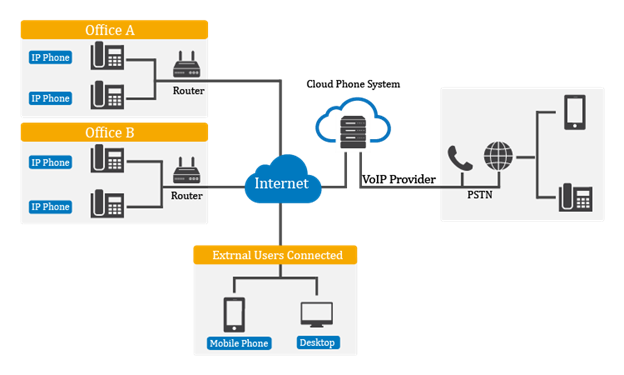Cloud-Based VoIP PBX Solutions
Category: Cloud Solution


Project Overview
This project involves deploying and managing cloud-based VoIP PBX solutions for various organizations in Sydney. The aim is to provide reliable, scalable, and cost-effective communication systems that meet the specific needs of each client. Leveraging partnerships with leading providers like RingCentral, we ensure seamless integration and comprehensive support throughout the deployment process.
Project Phases
Phase 1: Initial Assessment and Planning
- Requirement Analysis
- Stakeholder Meetings : Conduct meetings with key stakeholders to understand their communication requirements, existing infrastructure, and specific needs.
- Current Communication System Review : Assess the current communication system, including traditional PBX setups and existing VoIP solutions.
- Project Scope Definition
- Scope and Objectives : Define the project scope, objectives, timelines, and responsibilities.
- Compliance and Security : Ensure compliance with relevant industry regulations and security standards.
Phase 2: Solution Design and Preparation
- VoIP Solution Selection
- Vendor Evaluation : Evaluate cloud-based VoIP PBX solutions from leading providers such as RingCentral to select the best fit for the organization’s needs.
- License Procurement : Procure the necessary licenses for the chosen VoIP solution.
- Infrastructure Preparation
- Network Readiness : Ensure network readiness, including sufficient bandwidth, Quality of Service (QoS) settings, and firewall configurations.
- Hardware Inventory : Inventory existing hardware (phones, headsets, etc.) and identify any additional equipment needed.
Phase 3: VoIP Solution Deployment
- System Setup
- PBX Configuration : Set up the cloud-based PBX system, including extensions, call routing, voicemail, and auto-attendant settings.
- User Accounts : Create user accounts and configure access permissions based on roles.
- Hardware Deployment
- Phone Provisioning : Deploy and configure VoIP phones and softphones for all users.
- Network Configuration : Optimize the network for VoIP traffic to ensure high-quality voice communication.
Phase 4: Security and Compliance
- Security Configuration
- Encryption : Enable encryption for voice traffic to ensure secure communication.
- Access Control : Implement access control measures to secure the VoIP PBX system and user accounts.
- Compliance Measures
- Regulatory Compliance : Ensure the VoIP solution complies with relevant regulations and standards, such as privacy laws and data protection regulations.
- Audit and Monitoring : Set up auditing and monitoring tools to track call logs and system changes.
Phase 5: Testing and Validation
- Functionality Testing
- Call Quality Testing : Test the call quality to ensure clear and reliable voice communication.
- Feature Testing : Verify the functionality of all features, such as call forwarding, conferencing, and voicemail.
- Performance Testing
- Load Testing : Perform load testing to ensure the system can handle the expected call volume.
- Reliability Testing : Conduct reliability testing to ensure consistent service availability.
Phase 6: User Training and Documentation
- Training Sessions
- IT Staff Training : Conduct training sessions for IT staff on managing and maintaining the VoIP PBX solution, including troubleshooting common issues.
- End-User Training : Provide training for end-users on using the new VoIP system, including making calls, setting up voicemail, and using advanced features.
- Documentation
- Configuration Documentation : Document all configurations and settings of the VoIP PBX solution.
- User Guides : Provide user guides and troubleshooting documentation for common tasks and issues.
Phase 7: Go-Live and Post-Implementation Support
- Go-Live Preparation
- Final Checks : Perform final system checks and prepare for go-live.
- Communication : Inform users of the transition schedule and provide support contacts.
- Go-Live Execution
- System Monitoring : Monitor the system closely for any issues during the transition.
- User Support : Provide immediate support to address any issues that arise post-implementation.
- Post-Implementation Support
- Ongoing Support : Provide ongoing support and address any issues that arise post-implementation.
- System Monitoring : Implement continuous monitoring for performance and security.
Phase 8: Ongoing Monitoring and Maintenance
- Monitoring
- Call Quality Monitoring : Continuously monitor call quality and address any issues promptly.
- System Alerts : Set up alerts for any system anomalies or performance issues.
- Maintenance
- System Updates : Ensure the VoIP PBX solution is kept up-to-date with the latest patches and feature updates.
- User Feedback : Gather and act on user feedback to improve the VoIP solution and its implementation.
Key Considerations
- Cost Savings : Emphasize the cost savings achieved by transitioning to a cloud-based VoIP PBX solution, which eliminates the need for on-premises hardware and maintenance.
- Data Privacy and Security : Ensure all configurations adhere to data privacy and security standards, especially for sensitive business communications.
- User Experience : Minimize disruption during the transition and provide comprehensive support during the go-live phase.
- Scalability : Configure the system to scale with the growth of the companies and increasing call volumes.
- Compliance : Maintain compliance with industry-specific regulations and standards.
By following these steps, we ensure a successful deployment of cloud-based VoIP PBX solutions tailored to the needs of various organizations in Sydney, leveraging our partnership with RingCentral to deliver reliable, scalable, and secure communication systems.



